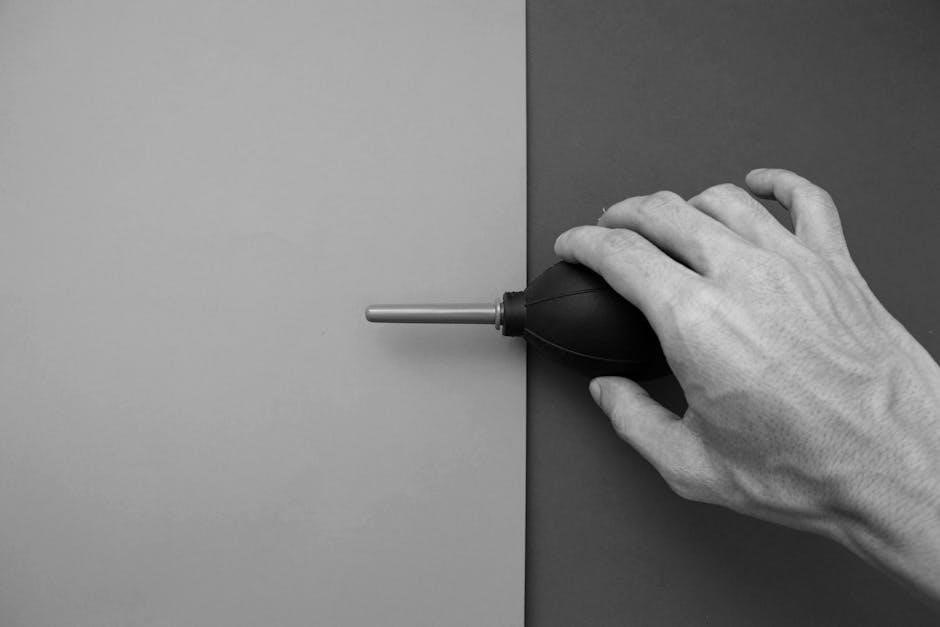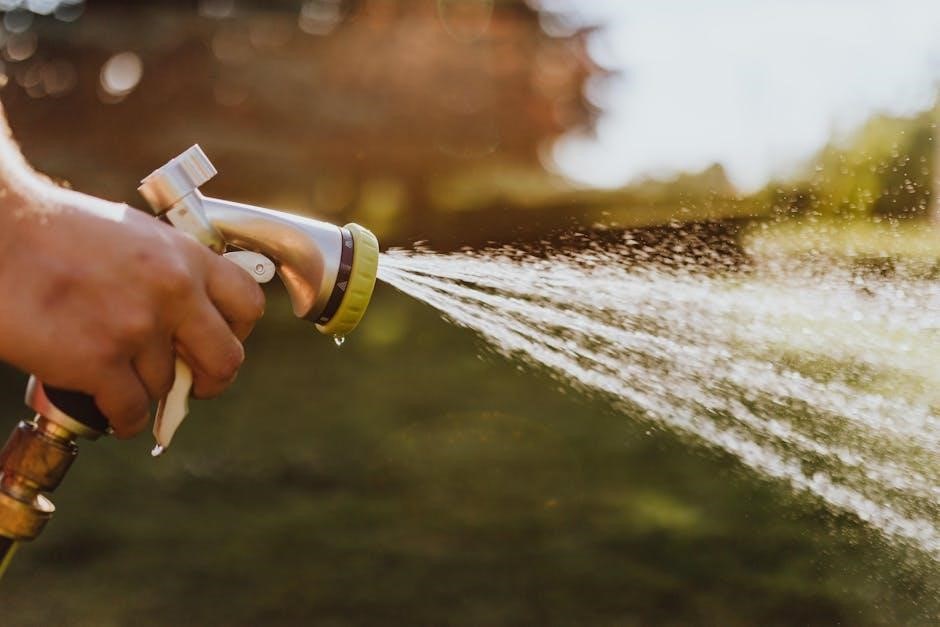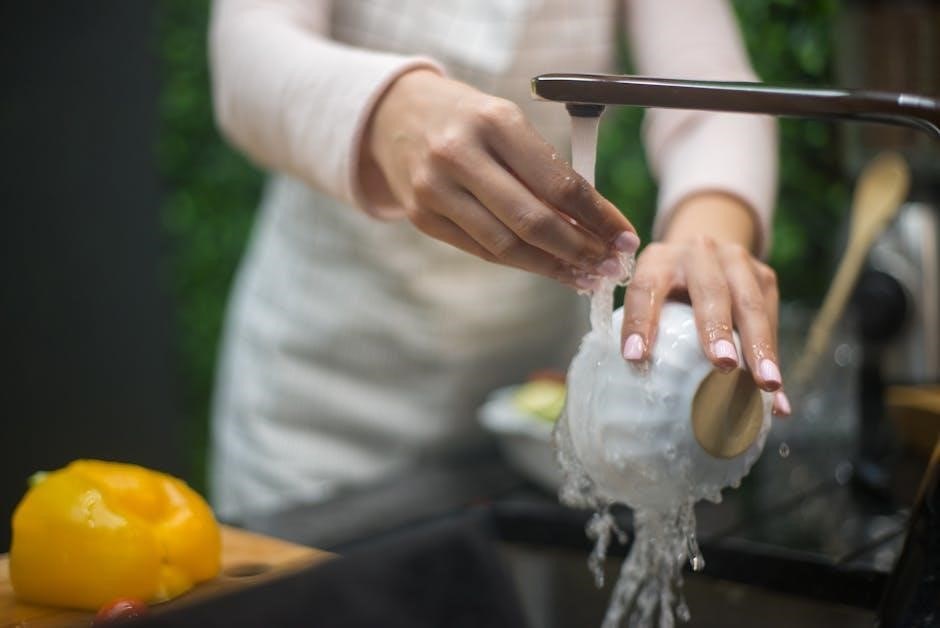
Manual fluid pumps are devices that use human effort to transfer fluids, relying on mechanisms like pistons, levers, and check valves to create suction and discharge.
1.1 Definition and Purpose
A manual fluid pump is a device that uses human effort to transfer fluids through mechanical motion. It operates by creating suction and discharge actions, often involving pistons, plungers, or screws. The primary purpose of these pumps is to move liquids from one location to another, such as water, oil, or hydraulic fluids. They are designed for simplicity, relying on levers, check valves, and connecting rods to function effectively. Manual pumps are essential for applications where electricity or automation is unavailable, offering a reliable and portable solution for fluid transfer needs.
1.2 Historical Background
Manual fluid pumps have their roots in ancient civilizations, where early humans developed primitive devices to move water for irrigation. The concept evolved over centuries, with the Middle Ages seeing the introduction of piston-based pumps for drainage and water supply. By the Industrial Revolution, manual pumps became more sophisticated, utilizing levers and check valves to enhance efficiency. These early designs laid the foundation for modern manual pumps, which are now essential tools in various industries, offering a reliable method for fluid transfer without the need for electricity.
1.3 Importance in Various Industries
Manual fluid pumps play a crucial role across multiple industries due to their simplicity and reliability. In water supply systems, they provide consistent pressure for distribution. Hydraulic systems rely on them for precise fluid control, enabling machinery operation. Oil extraction and transfer benefit from their portability in remote locations. Additionally, medical and laboratory settings utilize manual pumps for safe handling of fluids. Their versatility and cost-effectiveness make them indispensable in diverse applications, ensuring efficient fluid management without the need for complex infrastructure or electricity.
Working Principle of Manual Fluid Pumps
Manual fluid pumps operate by converting mechanical energy into hydraulic energy, using components like pistons, screws, or levers to create suction and propel fluids through systems efficiently.
2.1 Rotational Motion and Screw Mechanism

The rotational motion in manual fluid pumps is driven by human effort, converting it into mechanical energy. A screw mechanism, often with meshing threads, creates a progressive cavity effect, ensuring efficient fluid transfer. As the handle is turned, the screw rotates, capturing and propelling fluid through the pump. This design minimizes leakage and maintains consistent flow, making it ideal for viscous fluids. The screw’s helical shape ensures smooth operation, while its tight tolerances enhance pressure buildup, enabling reliable performance in various applications.
2.2 Piston and Plunger Operation
In manual fluid pumps, the piston and plunger system is integral to fluid transfer. When the lever is pressed, the piston moves upward, creating suction that draws fluid into the cylinder. As the lever is released, the plunger forces the fluid out through the discharge valve. This reciprocating motion ensures consistent flow. Check valves prevent backflow, maintaining efficiency. The simplicity of this mechanism makes it reliable for low-pressure applications, relying solely on manual effort to drive the piston-plunger assembly. This design is widely used in portable and cost-effective pumping solutions.
2.3 Role of Check Valves in Fluid Transfer
Check valves are crucial in manual fluid pumps, ensuring fluid flows in one direction. During suction, the inlet check valve opens, allowing fluid into the cylinder. As the piston rises, the outlet check valve opens, expelling fluid. Simultaneously, the inlet valve closes to prevent backflow. This unidirectional flow maximizes efficiency and prevents fluid reversal, ensuring smooth operation. The precise functioning of check valves is essential for maintaining consistent pressure and flow rates in manual pumping systems, making them indispensable for reliable fluid transfer.

Types of Manual Fluid Pumps
Manual fluid pumps are categorized into lever-operated, hand-crank, foot-operated, and squeeze-bulb pumps, each designed for specific applications and offering unique advantages in fluid transfer efficiency.
3.1 Lever-Operated Pumps
Lever-operated pumps utilize a lever mechanism to create the necessary motion for fluid transfer. When the lever is pressed downward, it drives a piston or plunger, drawing fluid into a cylinder. Upon release, the fluid is expelled through a discharge valve. These pumps are commonly used in water supply systems and hydraulic applications, offering simplicity and reliability. Their design often includes check valves to ensure one-way fluid flow, making them efficient for low-pressure environments. This mechanism is both durable and easy to maintain, providing consistent performance across various industries.
3.2 Hand-Crank Pumps
Hand-crank pumps operate by converting rotational motion into linear movement, typically driving a piston or plunger to transfer fluids. The crank is connected to a rod, which moves up and down inside a cylinder, creating suction and discharge strokes. Check valves ensure fluid flows in one direction, while the crank’s mechanical advantage reduces effort. These pumps are widely used in water supply systems, small-scale hydraulic applications, and oil transfer. Their durable design and ease of use make them ideal for low-pressure, portable fluid transfer solutions across various industries.
3.3 Foot-Operated Pumps
Foot-operated pumps utilize a foot pedal to drive the pumping mechanism, often employing a piston or diaphragm to transfer fluids. The pedal’s motion creates alternating suction and discharge cycles, with check valves ensuring one-way flow. These pumps are advantageous for hands-free operation, allowing users to manage other tasks simultaneously. Common applications include laboratories, medical settings, and industrial environments where precise fluid control is needed. Their design enhances efficiency and reduces fatigue, making them a practical choice for continuous or intermittent fluid transfer requirements.

3.4 Squeeze-Bulb Pumps
Squeeze-bulb pumps are small, portable devices that use a flexible bulb or diaphragm to create suction for fluid transfer. By manually compressing the bulb, users generate negative pressure, drawing fluid into the pump. A check valve ensures one-way flow, preventing backflow. These pumps are ideal for low-volume applications, such as inflating items or transferring small amounts of liquid. Their simplicity and compact design make them popular in medical, laboratory, and recreational settings, offering a reliable, low-cost solution for precise fluid control and transfer tasks.

Applications of Manual Fluid Pumps
Manual fluid pumps are essential in water supply systems, hydraulic machinery, and oil extraction, providing reliable fluid transfer in various industrial and domestic settings efficiently.
4.1 Water Supply Systems
Manual fluid pumps play a crucial role in water supply systems, especially in rural or emergency settings where electricity is unavailable. These pumps operate by creating suction to draw water from wells or reservoirs into cylinders. As the piston moves upward, water is expelled through a discharge valve, ensuring a steady supply. Their simplicity and reliability make them ideal for communities needing consistent access to clean water. This method is both cost-effective and sustainable for small-scale applications.
4.2 Hydraulic Systems
Manual fluid pumps are essential in hydraulic systems, where they generate pressure to perform tasks like lifting or clamping. By applying Pascal’s Law, these pumps transfer force through fluids, enabling precise control. They often feature pressure gauges to monitor output, ensuring safe operation. Ideal for low-pressure applications, manual pumps are reliable and portable, making them suitable for various hydraulic machinery. Their simplicity and effectiveness make them a preferred choice in industries requiring consistent fluid pressure without the need for complex automation.
4.3 Oil Extraction and Transfer
Manual fluid pumps play a crucial role in oil extraction and transfer processes, offering a reliable method to handle viscous fluids. These pumps use pistons or plungers to create suction, drawing oil from reservoirs or wells. Equipped with pressure gauges, they monitor output pressure, ensuring efficient transfer. Their portability and simplicity make them ideal for remote or low-infrastructure environments. Whether in small-scale extraction or industrial settings, manual pumps provide consistent performance, making them a vital tool in the oil industry for precise and controlled fluid management.
4.4 Medical and Laboratory Use
Manual fluid pumps are essential in medical and laboratory settings for precise fluid control. They are used to power surgical tools, handle sterile solutions, and operate medical devices requiring consistent pressure. Their compact design and reliability make them ideal for clinical environments. In laboratories, these pumps assist in transferring chemicals and maintaining controlled pressures during experiments. Safety and portability are key advantages, ensuring they meet stringent medical standards while providing efficient fluid management in critical healthcare applications.
Design and Components
Manual fluid pumps feature a piston and cylinder assembly, check valves, and seals to ensure efficient fluid transfer. The lever and connecting rod provide mechanical advantage, while pressure gauges monitor output.
5.1 Piston and Cylinder Assembly
The piston and cylinder assembly is the heart of manual fluid pumps, enabling fluid displacement. As the piston moves up and down within the cylinder, it creates suction and pressure, drawing fluid in and forcing it out. This mechanism is crucial for transferring liquids efficiently. The assembly is typically constructed from durable materials to withstand repeated use and maintain sealing integrity, ensuring reliable operation across various applications. Proper alignment and lubrication are essential for optimal performance.
5.2 Valves and Seals
Valves and seals are critical components in manual fluid pumps, ensuring efficient fluid transfer. Check valves control the flow direction, allowing fluid to enter and exit without backflow. Seals prevent leakage between moving parts, maintaining pressure and efficiency. Durable materials like rubber or metal are used for longevity. Proper valve operation and sealing are essential for consistent performance, minimizing maintenance and ensuring reliable fluid handling in various applications. These components work together to optimize pump functionality and prevent fluid loss.

5.3 Lever and Connecting Rod Mechanism
The lever and connecting rod mechanism in manual fluid pumps converts manual effort into mechanical motion. As the lever is moved, it actuates the connecting rod, which transfers this motion to the piston or plunger. This motion creates suction and discharge strokes, enabling fluid transfer. The lever amplifies the applied force, making it easier to operate the pump. The connecting rod ensures precise transmission of motion, maintaining efficiency and consistency in fluid flow. This mechanism is essential for the pump’s functionality, providing a reliable means of manual fluid displacement.
5.4 Pressure Gauges and Monitoring
Pressure gauges in manual fluid pumps play a crucial role in monitoring the output pressure during operation. These gauges provide real-time feedback, ensuring the pump operates within safe limits. By displaying the pressure levels, users can adjust their effort to maintain optimal performance. Monitoring pressure helps prevent over-pressurization, which could lead to equipment damage or failure. This feature is particularly important in hydraulic and oil transfer applications, where precise pressure control is essential for efficiency and safety. Regular checking of pressure gauges ensures reliable and consistent fluid transfer.
Operation and Maintenance
Proper operation involves following step-by-step guides to ensure efficient fluid transfer, while regular maintenance, like cleaning and lubricating parts, extends the pump’s lifespan and reliability.
6.1 Step-by-Step Operating Guide
To operate a manual fluid pump, start by ensuring all connections are secure. Prime the pump by slowly moving the lever or handle to create suction. Once fluid flows steadily, maintain a consistent pumping rhythm to avoid airlocks. Monitor pressure gauges to prevent over-pressurization. Regularly inspect for leaks and wear. After use, drain the system and clean the pump to prevent contamination. Always follow the manufacturer’s guidelines for optimal performance and safety. Proper technique ensures efficiency and longevity of the pump.
6.2 Troubleshooting Common Issues
Common issues with manual fluid pumps include airlocks, leaks, and slow operation. Airlocks can be resolved by priming the pump or bleeding the system. Leaks often stem from worn seals or loose connections, which should be tightened or replaced. Slow operation may indicate worn piston rings or clogged valves, requiring disassembly and cleaning. Regular inspection of moving parts and lubrication can prevent such problems. Always refer to the manufacturer’s manual for specific troubleshooting steps to ensure effective resolution and maintain pump efficiency. Prompt action prevents further damage and extends the pump’s lifespan.
6.3 Regular Maintenance Tips
Regular maintenance is crucial for optimal performance of manual fluid pumps. Clean the pump and its components regularly to prevent dirt buildup. Lubricate moving parts to reduce friction and wear. Inspect seals and valves for damage or leaks and replace them if necessary. Check the piston and cylinder for alignment and wear. Store the pump in a dry, protected area when not in use. Follow the manufacturer’s guidelines for maintenance schedules to ensure longevity and reliability. Proper care extends the pump’s lifespan and maintains its efficiency.
Advantages of Manual Fluid Pumps

Manual fluid pumps offer simplicity, reliability, and portability, making them ideal for various applications. They are cost-effective, require minimal setup, and provide consistent performance without electricity.
7.1 Simplicity and Reliability
Manual fluid pumps are known for their straightforward design and dependable operation. With fewer moving parts compared to electric pumps, they minimize the risk of mechanical failure. Their simplicity ensures easy maintenance and repair, making them a reliable choice for various applications. The absence of complex electronics or motors reduces the likelihood of breakdowns, ensuring consistent performance in both routine and emergency situations. This reliability makes manual pumps a preferred option for scenarios where simplicity and durability are essential.
7.2 Portability and Versatility
Manual fluid pumps are highly portable, making them ideal for use in remote or mobile applications. Their compact design and lightweight materials allow easy transportation, ensuring versatility across various settings. These pumps can handle different types of fluids, from water to oils, and are adaptable to diverse operational needs. Whether in emergency situations, fieldwork, or everyday use, their portability and versatility make them a practical solution for fluid transfer. This adaptability enhances their utility in both industrial and domestic environments.
7.3 Cost-Effectiveness
Manual fluid pumps are a cost-effective solution for fluid transfer needs. They require minimal initial investment and have low maintenance costs compared to electric or hydraulic pumps. Their simple design reduces the need for complex repairs, making them a budget-friendly option. Additionally, they eliminate the expense of electricity, further lowering operational costs. This makes them an economical choice for small-scale or temporary applications, providing reliable performance without financial strain. Their affordability and durability ensure long-term savings, making them a practical investment.

Limitations of Manual Fluid Pumps
Manual fluid pumps have limitations, including low flow rates, requiring physical effort, and suitability only for low-pressure applications, making them less efficient for large-scale operations.
8.1 Limited Flow Rate
Manual fluid pumps often struggle with limited flow rates due to their reliance on human effort, making them less efficient for large-scale fluid transfer. Their design, which typically involves pistons, plungers, and check valves, allows for precise control but restricts the volume of fluid that can be moved in a given time. This makes them more suitable for small-scale applications, such as water supply systems or oil transfer in low-pressure environments, rather than industrial processes requiring high-volume output.
8.2 Physical Effort Required
Manual fluid pumps require significant physical effort, as they depend on human power to operate. The repetitive motion of levers, handles, or pedals demands consistent energy input, which can be tiring over time. This makes them less practical for applications requiring continuous operation or high volumes of fluid transfer. Despite their portability and simplicity, the physical strain limits their use to small-scale or intermittent tasks, where human intervention is feasible and manageable. This limitation underscores their suitability for specific, low-demand scenarios rather than heavy-duty operations.
8.3 Restricted to Low-Pressure Applications

Manual fluid pumps are typically designed for low-pressure environments, making them unsuitable for high-pressure industrial tasks. Their mechanical limits, such as piston strength and valve durability, restrict their use to applications where pressure demands are minimal. This constraint ensures they perform efficiently in scenarios like water supply systems or small-scale fluid transfer, but they are not ideal for heavy-duty operations requiring high pressure. Their simplicity and cost-effectiveness make them a practical choice only where pressure requirements are modest and manageable within their design capabilities.

Safety Considerations
Proper handling and usage of manual fluid pumps are crucial to prevent accidents. Always follow manufacturer guidelines and ensure the system is pressure-tested before operation.
9.1 Proper Handling and Usage
Proper handling and usage of manual fluid pumps are essential to ensure safe and efficient operation. Always follow the manufacturer’s guidelines and inspect the pump for any damage before use. Ensure all components, such as check valves and pistons, are functioning correctly. Use the correct technique to operate the pump, avoiding excessive force that could lead to mechanical failure. Monitor the pressure gauge to prevent over-pressurization, and wear protective gear like gloves and safety glasses. Regular maintenance and proper storage are also critical to extend the pump’s lifespan and reliability.
9.2 Pressure Management
Proper pressure management is crucial when operating manual fluid pumps to prevent over-pressurization and potential damage. Always monitor the pressure gauge to ensure it stays within the recommended range. Excessive pressure can lead to mechanical failure or fluid leakage. Use the pump’s built-in relief mechanisms to safely release pressure when necessary. Understanding principles like Pascal’s Law, which relates pressure distribution, can help optimize pump performance. Regularly check for worn or damaged seals and valves, as they can compromise pressure control. Maintain a steady, controlled motion when operating the pump to avoid pressure spikes.
9.3 Environmental and Safety Precautions
When using manual fluid pumps, adhere to environmental and safety guidelines to minimize risks. Always wear protective gear, including gloves and goggles, to prevent exposure to harmful fluids. Ensure the pump is used in a well-ventilated area to avoid inhaling fumes. Properly dispose of any spilled fluids to prevent environmental contamination. Follow manufacturer instructions for handling hazardous materials. Regularly inspect the pump for leaks or damage to maintain safe operation. Keep the pump away from open flames or sparks to reduce fire hazards.
Conclusion
Manual fluid pumps are essential tools offering simplicity, reliability, and cost-effectiveness across various industries. Their versatility in applications, from water supply to hydraulic systems, makes them indispensable. While they require physical effort and have limitations in flow rate and pressure, proper maintenance and safety precautions ensure efficient operation. As technology advances, manual pumps remain a practical solution for low-pressure and portable fluid transfer needs, providing a sustainable option for both industrial and everyday use.